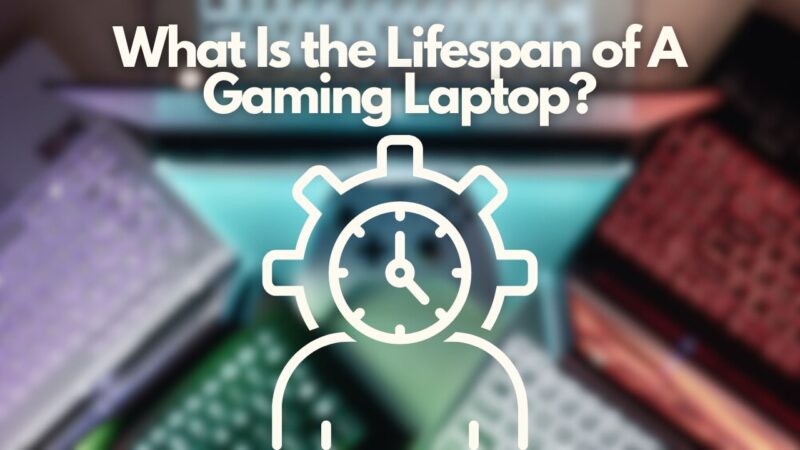Gaming laptops are great for someone who needs the portability of a regular laptop but the power of a gaming system. However, as widely known, gaming accessories and components such as pre-built PCs or laptops can cost a lot of money, depending on the specifications. But why are gaming laptops so expensive?
Gaming laptops are so expensive because every manufacturer has their own design layout, and parts are not interchangeable. Also, manufacturing costs are higher compared to traditional PC parts because they have to fit into a small laptop case.
If you compare a gaming laptop to a gaming desktop with the same system specifications, you’ll see that the desktop is much more powerful. Standard PC cases have much more space to fit all components, resulting in greater heat distribution and more cooling options.
Here Is Why Gaming Laptops Are so Expensive Greater Detail:

Smaller Form Factor: PC cases are available in many different sizes and offer a lot of free space to fit all modern components, such as the GPU, motherboard, RAM, SSD, HDD, and more. PC components are relatively large compared to laptop components, allowing higher performance, more features, and better cooling.
On the other hand, most laptop cases are quite similar in size (with some exceptions). Manufacturers such as Razer, Dell, HP, or Alienware have to size all parts down to fit them into the thin case without sacrificing too much performance. They also have to leave some space for cooling.
Building smaller parts with roughly the same performance costs more, increasing the sales price of the final product. The smaller form factor is also the key reason why a gaming laptop performs worse than a desktop with the same specifications. To prevent overheating, components run at lower clock speeds and voltages.
Cooling and Heat Distribution: One of the biggest problems with gaming laptops is the cooling and heat distribution. Modern PC cases can easily fit +6 fans, compared to 2-3 laptops that can fit at max. Finding, designing, and building a brand-new cooling system takes quite some time, and manufacturing costs also raise quite a bit.
No Interchangeable Parts: Because most manufacturers have their own design, cooling solutions, and plans, usually, no parts of a gaming laptop are interchangeable. With standard gaming PCs, you can swap out the GPU, CPU, and motherboard and replace it with a better version.
Interchangeable parts are an excellent opportunity to cut down a product’s cost by using an already existing, well-performing component. Because most manufacturers don’t focus on such interchangeable parts, the manufacturing cost is higher.
No Standardization: In gaming desktops, the position of components generally stays the same, making it easier and cheaper to design new products. However, with gaming laptops, the layout, thermal solution, and layout vary between manufacturers, increasing the cost of developing a new laptop.
Development & Manufacturing: All in all, building a new gaming laptop is a costly act because of lacking standardization and no interchangeable parts. Designers have to find a design where all components fit into the case, including a cooling system that keeps the system at consistent temperatures.
Remember, laptops tend to run hot under heavy tasks, especially at playing hardware-demanding games. If the system runs too hot, parts could melt and catch fire. Take a minute and search for exploding laptop or laptop catches fire on YouTube if you want to see what I mean.
Branding: If you ever bought a product from a popular brand such as Razer or Nvidia, you know that their products tend to be more expensive than similar products from other brands.
Whenever you buy a product from such brands, you will also pay a premium price because you’re not only purchasing the product but also the reputation that it comes with.
Is It Worth It to Buy a Gaming Laptop?
Whenever you’re close to making the final purchase decision, hold on and think the last time about it. Especially if the product you want costs a good chunk of money, such as gaming laptops. So, are they worth it to buy?
Gaming laptops are worth buying if you want to play games on the go and at home. However, if the gaming laptop is only used at home, you should settle with a traditional gaming desktop for a better price-to-performance ratio.
If your focus is not 100% on gaming on the go, but you want to use the system for video editing or other hardware-demanding tasks, it could be well worth buying a gaming laptop.
Gaming laptops can also be used for school, as they work just like any other traditional laptop, despite being much more powerful. If you want to know more about using gaming laptops for school and work, make sure to check out our article.
Here is a list of the pros and cons of a standard gaming laptop:
| Pros of Gaming Laptops: | Cons of Gaming Laptops: |
|---|---|
| Great gaming performance (depends on the GPU model!) | Bad performance/price ratio |
| Light and thin designs available | More expensive than desktops |
| Can be used for work and school besides gaming | Laptop parts perform worse than their desktop versions |
| Portable | Generally bad battery life |
| Usage of high-quality materials | Almost non-upgradability |
What Is the Lifespan of A Gaming Laptop?

Usually, the amount of money you spend on a product reflects the quality. Desktop PCs have great lifespans if the owner chooses the right components. But how is it with gaming laptops, as they are not known for their upgradeability?
Gaming laptops can last up to 10 years or more physically, but they tend to lose performance after 2-3 years. More expensive models tend to last longer because of more high-quality materials and a larger overhead in power.
That said, you don’t have to pay a fortune for a gaming laptop, just that he lasts longer. With a bit of care, you can increase the lifespan of your gaming system.
Especially the battery needs proper care, as constant charging, overcharging, overheating, and fast temperature changes can decrease the lifespan drastically, and make it drain faster.
If you have a separate pair of batteries for your gaming laptop, make sure to store them right, so they don’t lose storage capacity and get damaged over time. According to BatteryUniversity’s article, you should store Lithium-based batteries at 40-50% charge on 0°C for the best results.
Conclusion
In the realm of gaming, laptops have carved a niche for themselves, offering a blend of portability and power that is hard to resist for the gaming enthusiast on the go. The price tag, however, can be a deterrent. The reasons for this are manifold, from the intricacies of miniaturizing high-performance components to fit the compact form factor to the challenges of efficient cooling and heat distribution in such a confined space.
The lack of interchangeable parts and standardization across manufacturers further compounds the cost. Each gaming laptop is a unique blend of design and engineering, tailored to balance performance and portability. The cost of developing and manufacturing these bespoke machines is inevitably passed on to the consumer.
Yet, despite the higher price point, gaming laptops offer undeniable advantages. They provide robust gaming performance in a package that can be easily carried to school, work, or on travels. While their performance-to-price ratio may not match that of their desktop counterparts, the flexibility they offer is unparalleled.
However, it’s essential to consider the longevity of these devices. While physically they can last up to a decade, their performance may start to wane after a few years. Careful maintenance, particularly of the battery, can extend their lifespan and ensure they remain a worthwhile investment.







